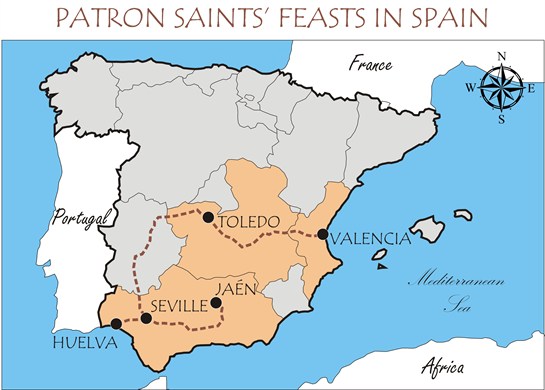Patronal Feasts in Spain
 Every Spanish town celebrates the feast day of at least one patron saint, to which other important religious occasions are often added, in which statues, groups of statues or scenic apparatuses (“machines”) are carried in procession to stage episodes inspired by the Holy Scriptures, to lives of the saints and the most famous mysteries of the Christian religion. There is a particular type of feast days of patron saints that also involve the staging of symbolic battles and armed conflict: the famous celebrations of Moors and Christians. During the feast days of patron saints in Spain, the effigies of the patron saints or biblical scenes are taken in procession on beautiful wooden pageants that the Spanish call pasos: the same term used to indicate the statuary groups that parade during Holy Week. From the endless repertoire of festivals in Spain, we decided to select some examples that can give an idea of how much our age is still steeped in ritual born or developed during the Baroque era. We decided to place Saint Isidore, the famous feast which is celebrated in the capital, Madrid, alongside the equally impressive Fiesta de la Virgen de la Salud that takes place in a city in the province of Valencia (Algemesí). Our research, then, has focused on Corpus Christi processions. In the past, especially during the Baroque era, the celebrations envisaged the setting up of extraordinary scenic apparatuses, of which, in many places there are no traces. This is not the case with many Spanish cities like Valencia, Toledo or Seville in which storied rites are relived, even though they are adapted to our times, in all of their splendour. During such events traditional dances are performed, among them that of the Giants and Dwarfs.
Every Spanish town celebrates the feast day of at least one patron saint, to which other important religious occasions are often added, in which statues, groups of statues or scenic apparatuses (“machines”) are carried in procession to stage episodes inspired by the Holy Scriptures, to lives of the saints and the most famous mysteries of the Christian religion. There is a particular type of feast days of patron saints that also involve the staging of symbolic battles and armed conflict: the famous celebrations of Moors and Christians. During the feast days of patron saints in Spain, the effigies of the patron saints or biblical scenes are taken in procession on beautiful wooden pageants that the Spanish call pasos: the same term used to indicate the statuary groups that parade during Holy Week. From the endless repertoire of festivals in Spain, we decided to select some examples that can give an idea of how much our age is still steeped in ritual born or developed during the Baroque era. We decided to place Saint Isidore, the famous feast which is celebrated in the capital, Madrid, alongside the equally impressive Fiesta de la Virgen de la Salud that takes place in a city in the province of Valencia (Algemesí). Our research, then, has focused on Corpus Christi processions. In the past, especially during the Baroque era, the celebrations envisaged the setting up of extraordinary scenic apparatuses, of which, in many places there are no traces. This is not the case with many Spanish cities like Valencia, Toledo or Seville in which storied rites are relived, even though they are adapted to our times, in all of their splendour. During such events traditional dances are performed, among them that of the Giants and Dwarfs.
